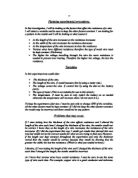P2.4 Static Electricity Some insulating materials can become electrically charged when they are rugged against each other. This static electricity builds up when electrons (negatively charged) are ‘rubbed off’ one material onto another. The material that gains electrons becomes negatively charged. The material that loses electrons is left with a positive charge. E.g. 1 rubbing a polythene rod with a dry cloth transfers electrons to the rod from the cloth. Therefore, the rod gains electrons and so becomes negatively charged while the cloth loses electrons and becomes positively charged. E.g. 2 rubbing Perspex rod with a dry cloth transfers electrons from the rod onto the cloth. Therefore, the rod loses electrons and so becomes positively charged while the cloth gains electrons and becomes negatively charged. When two







